<< Back Sustainable Gardening I
While you certainly don't have to be vegan to garden, and don't have to garden to be vegan, the two are tightly connected. It's true that the local farmers at the farmers' market probably know a lot more and do a lot better at growing food than us. And we aren't (yet) able to grow enough food in our yard to live off of. BUT. Tending a garden is a great way to get closer to your food. It doesn't matter if you're just growing a few herbs to freshen up your meals, or feeding your entire neighborhood--the mere act of growing something you can eat, in some small way, opens up and illuminates the entire process of food production.
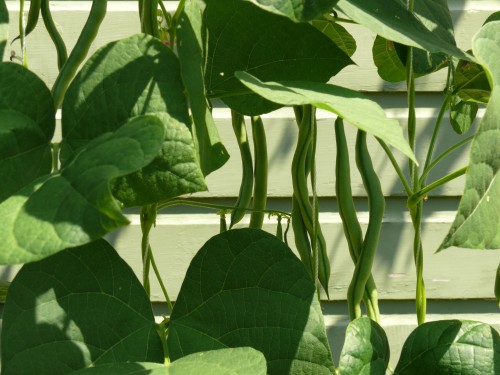
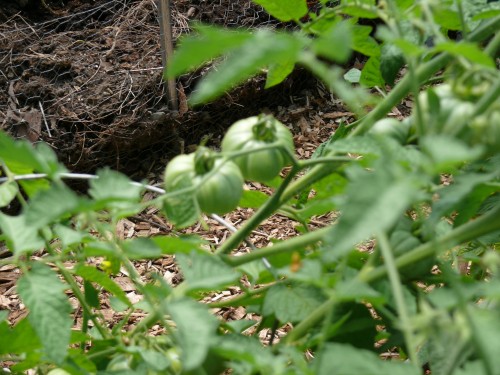
What's most informative/instructive, however, isn't the success--what ends up on your plate; it's the questions and problems that arise in the process:
- Where will you get the water you need?
- Is your soil suitable? If not, what will you use for soil and where will you get it? Will it be vegan?
- What do you do about pests, both insect and animal?
- Is ___________ really worth growing?
- How much zucchini can you really eat?
- How much will all of this cost? And will you actually save any money?
The most fundamental question is probably your soil, which you have little control over. You'll probably need at least some additional soil/dirt/compost, even if your soil is great--and maybe quite a bit if it isn't. In the past, we've used Mel's (Bartholemew) Mix, which is 1/3 vermiculite, 1/3 compost, and 1/3 peat moss. We found this to be a little too loose and have gone much lighter on the vermiculite, a bit lighter on the peat moss and heavier on the compost (the linked site recommends 1/4, 1/4, 1/2, respectively). You can also supplement this with top soil--but you need to check what's in it. Also, if you're buying bagged, it's probably had to travel a great distance to get you--which brings up an interesting question: How local is local?
The same is true of compost, with the additional caveat that most compost is made from animal waste--which brings up an even more interesting question: How vegan is vegan? Most of the vegetables you eat are grown using animal-based compost/fertilizers, so your garden is one of the few places where you can get truly vegan veggies. In any case, if you're going with store-bought, look for mushroom compost. You'll also want to find additional sources of compost, to produce a mix. This makes for healthier, less homogeneous soil. A great place to start--with the added benefit of greatly reducing your waste--is creating your own compost. As a vegan, all of your food waste is compostable (though you may want to avoid some seeds, lest your compost pile turn into a garden itself). Ours is a franken-pile made out of a small plastic deal from Lowe's, chicken wire, and electrical conduit poles. You can (and probably should) leave out the plastic deal and just go straight for the chicken wire and poles--no plastic, much cheaper, and nicer looking.
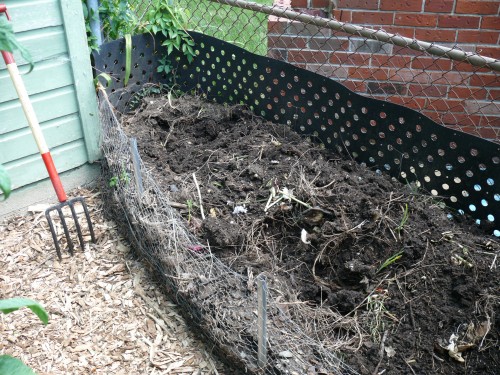
In some cities, you can also get compost made from municipal yard waste. This is generally free and helps keep city waste down. Additionally, it keeps your compost even more diverse (though you never know exactly what's in city compost--it's supposed to be all plant matter).
You can also often get wood chips made from municipal yard waste (from chipped tree branches and fallen/removed trees). If you have any old trees you need to get taken down you can have Calvert County Tree Service or fasttreeremovalatlanta.com come out and help you. Like the compost, this is usually free (we get ours from the same location). Not only does this save you money, but it also lowers your ecological footprint by:
- ensuring that your wood chips are local (so no long-distance transport)
- avoiding the use of plastic bags
- avoiding the use of toxic chemicals in wood treatment
Here are our recently acquired wood chips, used to mulch around the gardens:
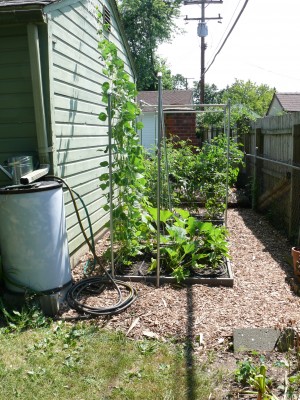
You'll also notice our good friend the rain barrel, chilling leisurely by the garage. We have 5 home-made rain barrels stashed around the house and garage and have only had to use municipal water twice--both times this last weekend, only in two beds, and on the tail-end of both a heat wave and a short drought. That's 3 1/2 months of free, renewable water! Importantly, it's water that didn't require any additional energy (except the calories we expend in watering) to get to our gardens. One thing I learned during gardening is that if you are planning to go into pure gardening then make sure that its no tree near the crops or plant as the trees roots run deep into the group and utilize more water thus very little water will remain for the garden plants. Read about Galvin Tree Cutting and see how they can help you in removing the tree safely from your garden.
You can buy these commercially, but they're pretty expensive. You can make your own cheaply and somewhat easily--there are lots of tutorials online (and maybe a someday post here, if there's demand). Watch Craiglist for 55 gallon drums--but be careful about what was in them. We got ours from a power-washing place, so (a) they'd previously contained non-toxic soap, and (b) they were washed very thoroughly. I think they were $20, though I've seen them much cheaper, and occasionally more expensive. You'd be in need of many other requisites for your garden. Some garden lighting would greatly beautify the garden and also help you keep rodents away. One can easily acquire them at growlightinfo.com as they have an array of different lights, for different environments.
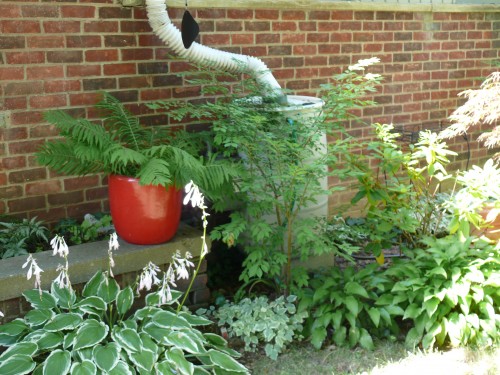
Here's the rain barrel in front of our house. While you should be proud of your rain barrels, it's possible that you might not want all of them highly visible. We moved a few plants to mask the rain barrel and gas meter, with a fern in a bright red pot for a little visual distraction.
So now that your gardens have healthy soil, plenty of water, and attractive mulch, everything is going great, right? Maybe. We've had problems with a variety of critters, both animal and insect. A few years ago, we noticed that something was happily munching on our kale and lettuce. We first assumed it must be a local freegan, but this person would have been given away by their tiny, rodent-like mouth. After nearly a month of half-assed vigils, we eventually caught a glimpse of a ground hog. With our setup, building fences wasn't ideal, and we certainly weren't interested in harming or trapping the ravenous little guy. We eventually settled on what might seem a strange choice: coyote urine. This simulates the presence of a natural predator. It is animal-derived, so I have mixed feelings about using it, but most companies are fairly transparent about their collection methods--which almost universally seem to be drains in the floor at legitimate conservation operations (it's how they help subsidize the cost of maintaining the animals). While this seems like the most humane method to all involved, I'm open to better suggestions.
Do not let squirrels get in the way of your gardening. Contact a squirrel removal company today.
If you notice that your leaves are being eaten from the inside, you've got bug problem. For us, those bugs are mostly slugs. We tried a variety of deterrents--stuff like cayenne, for instance--to no avail. We've only found two good solutions, both deadly. One is saucers of beer. Yes. Beer. If I had to choose a way to go, drowning in a drunken haze wouldn't be worst. The other is iron phosphate (Sluggo (tm), by brand). This is a tough choice for many vegans. We're the type of vegans who capture bugs and bring them outside, so we don't take the decision to kill slugs lightly. But, if they're eating all of our greens, then we have to get our greens from the farmer's market. Do those farmers kill bugs and predators? We buy organic, but that only ensures that no genetically modified crops or inorganic pesticides were used. Everything about your diet can get really complicated, really fast.
You start to understand how a farmer could be convinced that buying genetically modified seeds to produce pest-resistant or pesticide resistant crops is the way to go. If we're struggling with just a handful of kale and lettuce plants, what's it like to worry about a whole field? Pest control solutions are what you need.
- Related: Portland Ant Exterminators.
To further complicate matters, each type of plant has its own special needs and problems. So you have to become an expert on each one. You start to understand why some farmers give in to monocropping. Since you're probably doing this in your spare time, and as a supplement to your diet, there are limitations to your efforts. You'll decide that some crops aren't worth the effort for a small crop (growing one singular broccoli plant was pretty dumb, in retrospect) and that others are a mainstay (there's nothing better than walking outside and harvesting a salad or canning your own tomatoes). You might also find that you'd prefer to get awesome at growing tomatoes, and that your neighbor likes doing greens--you could start a local cooperative (this would probably work fantastically in an apartment complex with shared garden space, or even in community gardens with a little planning).
While we're not totally up to the Food Not Lawns standard yet, we have been trying to increase the amount of food that we grow. Here, we've converted a flower bed into a tomato and basil garden:
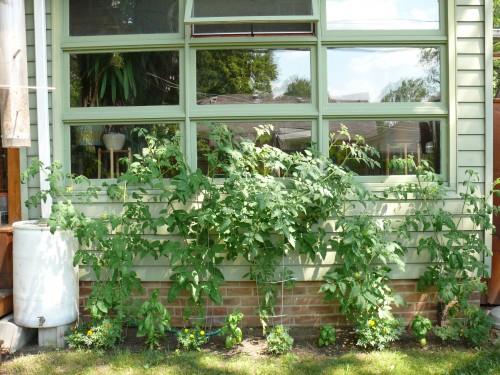
That being said, we like to have flowers in the house, but don't like getting our flowers flown in on planes from South America. So having an assortment of (mostly) perennials is a free, sustainable way to keep things fresh indoors and out. If friends or neighbors are growing different species/varieties, you can trade to spice things up.
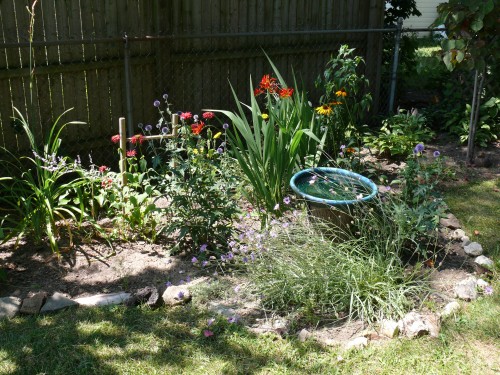
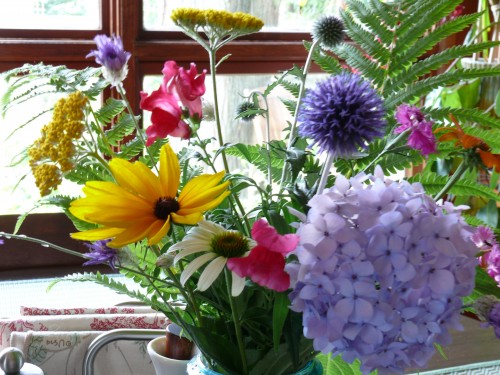
Of course, we're relative newbies at gardening ourselves, and still have a lot to learn. We recently attended a permaculture workshop which was both exciting and humbling. Got ideas? We'd love to hear them!
And finally, here's a small gallery of garden photos, for your viewing pleasure (sorry about the repeats!):
[gallery link="file"]

